Interferon beta-1a
Editor-In-Chief: C. Michael Gibson, M.S., M.D. [1]; Associate Editor(s)-in-Chief: Deepika Beereddy, MBBS [2]
Disclaimer
WikiDoc MAKES NO GUARANTEE OF VALIDITY. WikiDoc is not a professional health care provider, nor is it a suitable replacement for a licensed healthcare provider. WikiDoc is intended to be an educational tool, not a tool for any form of healthcare delivery. The educational content on WikiDoc drug pages is based upon the FDA package insert, National Library of Medicine content and practice guidelines / consensus statements. WikiDoc does not promote the administration of any medication or device that is not consistent with its labeling. Please read our full disclaimer here.
Overview
Interferon beta-1a is an immunologic adjuvant that is FDA approved for the treatment of multiple sclerosis. Common adverse reactions include flu-like symptoms including chills, fever, myalgia, and asthenia.
Adult Indications and Dosage
FDA-Labeled Indications and Dosage (Adult)
Multiple Sclerosis, Relapsing forms
AVONEX (interferon beta-1a) is indicated for the treatment of patients with relapsing forms of multiple sclerosis to slow the accumulation of physical disability and decrease the frequency of clinical exacerbations. Patients with multiple sclerosis in whom efficacy has been demonstrated include patients who have experienced a first clinical episode and have MRI features consistent with multiple sclerosis.
- Dosing Information
- AVONEX is administered intramuscularly.
- The recommended dose is 30 micrograms once a week. To reduce the incidence and severity of flu-like symptoms that may occur when initiating AVONEX therapy at a dose of 30 micrograms, AVONEX may be started at a dose of 7.5 micrograms and the dose may be increased by 7.5 micrograms each week for the next three weeks until the recommended dose of 30 micrograms is achieved (see Table 1). An AVOSTARTGRIP kit containing 3 titration devices can be used for titration and is to be used only with AVONEX Prefilled Syringes.

Off-Label Use and Dosage (Adult)
Guideline-Supported Use
There is limited information regarding Off-Label Guideline-Supported Use of Interferon Beta-1A in adult patients.
Non–Guideline-Supported Use
Multiple sclerosis, Clinically Isolated Syndrome
Efficacy has been demonstrated in patients who have experienced a first clinical episode and have MRI features consistent with multiple sclerosis.
Pediatric Indications and Dosage
FDA-Labeled Indications and Dosage (Pediatric)
Safety and effectiveness in pediatric patients have not been established.
Off-Label Use and Dosage (Pediatric)
Guideline-Supported Use
There is limited information regarding Off-Label Guideline-Supported Use of Interferon Beta-1A in pediatric patients.
Non–Guideline-Supported Use
There is limited information regarding Off-Label Non–Guideline-Supported Use of Interferon Beta-1A in pediatric patients.
Contraindications
AVONEX is contraindicated in patients with a history of hypersensitivity to natural or recombinant interferon beta, or any other component of the formulation.
The lyophilized vial formulation of AVONEX is contraindicated in patients with a history of hypersensitivity to albumin (human).
Warnings
Depression, Suicide, and Psychotic Disorders
Patients treated with AVONEX and their caregivers should be advised to report immediately any symptoms of depression, suicidal ideation, and/or psychosis to their prescribing physicians. If a patient develops depression or other severe psychiatric symptoms, cessation of AVONEX therapy should be considered.
Depression and suicide have been reported to occur with increased frequency in patients receiving AVONEX. In Study 1, the incidence of depression was similar in placebo-treated and in AVONEX-treated patients, but suicidal tendency was seen more frequently in AVONEX-treated patients (4% in AVONEX group vs. 1% in placebo group). In Study 2, there was a greater incidence of depression in AVONEX-treated patients than in placebo-treated patients (20% in AVONEX group vs. 13% in placebo group) [see Clinical Studies (14)].
Additionally, there have been post-marketing reports of depression, suicidal ideation, and/or development of new or worsening of other pre-existing psychiatric disorders, including psychosis. For some of these patients, symptoms of depression improved upon cessation of AVONEX.
Hepatic Injury
Severe hepatic injury, including cases of hepatic failure, has been reported rarely in patients taking AVONEX. Asymptomatic elevation of hepatic transaminases has also been reported, and in some patients has recurred upon rechallenge with AVONEX. In some cases, these events have occurred in the presence of other drugs that have been associated with hepatic injury. The potential risk of AVONEX used in combination with known hepatotoxic drugs or other products (e.g., alcohol) should be considered prior to starting AVONEX, or before starting hepatotoxic drugs. Patients should be monitored for signs of hepatic injury.
Anaphylaxis and Other Allergic-Reactions
Anaphylaxis has been reported as a rare complication of AVONEX use. Other allergic reactions have included dyspnea, orolingual edema, skin rash and urticaria. Discontinue AVONEX if anaphylaxis or other allergic reactions occur.
Congestive Heart Failure
Patients with pre-existing congestive heart failure should be monitored for worsening of their cardiac condition during initiation of and continued treatment with AVONEX. While beta interferons do not have any known direct cardiac toxicity, during the post-marketing period cases of congestive heart failure, cardiomyopathy, and cardiomyopathy with congestive heart failure have been reported in patients without known predisposition to these events, and without other etiologies being established. In some cases, these events have been temporally related to the administration of AVONEX. In some of these instances recurrence upon rechallenge was observed.
Decreased Peripheral Blood Counts
Decreased peripheral blood counts in all cell lines, including rare pancytopenia and thrombocytopenia, have been reported from postmarketing experience in AVONEX-treated patients. In some cases, platelet counts were below 10,000/microliter. Some cases recurred with rechallenge. Patients should be monitored for symptoms or signs of decreased blood counts.
Seizures
Seizures have been temporally associated with the use of beta interferons in clinical trials and postmarketing safety surveillance. In the two placebo-controlled studies in multiple sclerosis (Studies 1 and 2), 4 patients receiving AVONEX experienced seizures, while no seizures occurred in the placebo group. Three of these 4 patients had no prior history of seizure. It is not known whether these events were related to the effects of multiple sclerosis alone, to AVONEX, or to a combination of both.
Autoimmune Disorders
Post-marketing reports of autoimmune disorders of multiple target organs in AVONEX-treated patients included idiopathic thrombocytopenia, hyper- and hypothyroidism, and rare cases of autoimmune hepatitis. If AVONEX-treated patients develop a new autoimmune disorder, consider stopping the therapy.
Laboratory Tests
In addition to those laboratory tests normally required for monitoring patients with multiple sclerosis, complete blood and differential white blood cell counts, platelet counts, and blood chemistries, including liver function tests, are recommended during AVONEX therapy.
Patients with myelosuppression may require more intensive monitoring of complete blood cell counts, with differential and platelet counts. Thyroid function should be monitored periodically. If patients have or develop symptoms of thyroid dysfunction (hypo- or hyperthyroidism), thyroid function tests should be performed according to standard medical practice.
Adverse Reactions
Clinical Trials Experience
Because clinical trials are conducted under widely varying conditions, adverse reaction rates observed in the clinical trials of AVONEX cannot be directly compared to rates in clinical trials of other drugs and may not reflect the rates observed in practice.
Among 351 patients with relapsing forms of MS treated with AVONEX 30 micrograms (including 319 patients treated for 6 months and 288 patients treated for greater than one year) the most commonly reported adverse reactions (at least 5% more frequent on AVONEX than on placebo) were flu-like symptoms. Symptoms can include chills, fever, myalgia and asthenia occurring within hours to days following an injection. Most people who take AVONEX have flu-like symptoms early during the course of therapy. Usually, these symptoms last for a day after the injection. For many people, these symptoms lessen or go away over time. The most frequently reported adverse reactions resulting in clinical intervention (for example, discontinuation of AVONEX or the need for concomitant medication to treat an adverse reaction symptom) were flu-like symptoms and depression.
Table 2 enumerates adverse reactions that occurred with AVONEX-treated patients at an incidence of at least 2% more than that observed in the placebo-treated patients in the pooled placebo-controlled studies in patients with relapsing forms of MS.
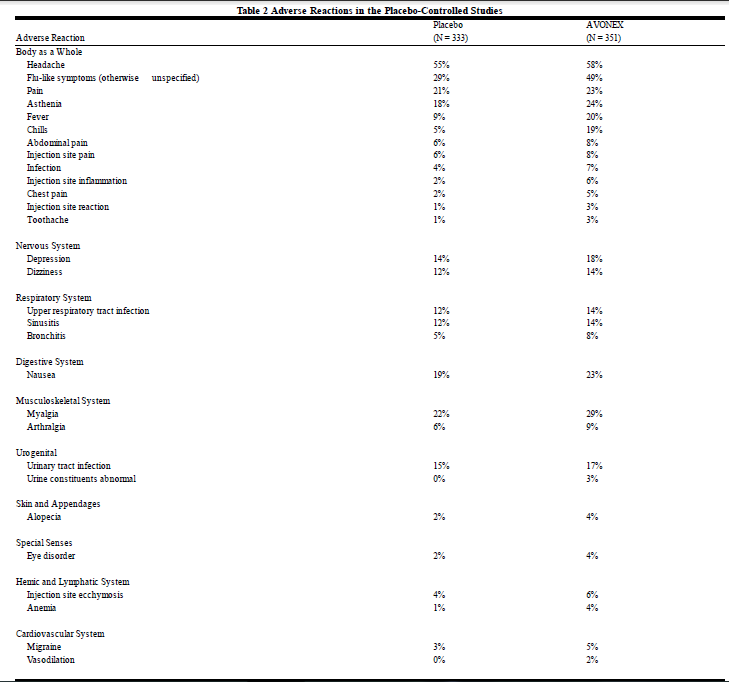
Immunogenicity
Anaphylaxis and other allergic reactions have occurred in AVONEX-treated patients. As with all therapeutic proteins, there is a potential for immunogenicity. In studies assessing immunogenicity in multiple sclerosis patients administered AVONEX for at least 1 year, 5% (21 of 390 patients) showed the presence of neutralizing antibodies at one or more times.
These data reflect the percentage of patients whose test results were considered positive for antibodies to AVONEX using a two-tiered assay (ELISA binding assay followed by an antiviral cytopathic effect assay), and are highly dependent on the sensitivity and specificity of the assay. Additionally, the observed incidence of neutralizing activity in an assay may be influenced by several factors including sample handling, timing of sample collection, concomitant medications, and underlying disease. For these reasons, comparison of the incidence of antibodies to AVONEX with the incidence of antibodies to other products may be misleading.
Postmarketing Experience
The following additional adverse reactions have been identified during post-approval use of AVONEX. Because these reactions are reported voluntarily from a population of uncertain size, it is not always possible to reliably estimate their frequency or establish a causal relationship to drug exposure.
- Menorrhagia and metrorrhagia
- Rash (including vesicular rash)
- Rare cases of injection site abscess or cellulitis requiring surgical intervention
Drug Interactions
Rotavirus Vaccine, Live
Interaction Effect: an increased risk of infection by the live vaccine
Zidovudine
Interaction Effect: zidovudine toxicity (lethargy, fatigue, anemia)
Use in Specific Populations
Pregnancy
Pregnancy Category (FDA): C Pregnancy Category C: There are no adequate and well-controlled studies in pregnant women. AVONEX should be used during pregnancy only if the potential benefit justifies the potential risk to the fetus.
In pregnant monkeys given interferon beta at 100 times the recommended weekly human dose (based upon a body surface area [mg/m2] comparison), no teratogenic or other adverse effects on fetal development were observed. Abortifacient activity was evident following 3 to 5 doses at this level. No abortifacient effects were observed in monkeys treated at 2 times the recommended weekly human dose (based upon mg/m2).
Pregnancy Category (AUS):
There is no Australian Drug Evaluation Committee (ADEC) guidance on usage of Interferon Beta-1A in women who are pregnant.
Labor and Delivery
There is no FDA guidance on use of Interferon Beta-1A during labor and delivery.
Nursing Mothers
It is not known whether AVONEX is excreted in human milk.
Pediatric Use
There is no FDA guidance on the use of Interferon beta-1a in pediatric settings.
Geriatic Use
There is no FDA guidance on the use of Interferon beta-1a in geriatric settings.
Gender
There is no FDA guidance on the use of Interferon beta-1a with respect to specific gender populations.
Race
There is no FDA guidance on the use of Interferon beta-1a with respect to specific racial populations.
Renal Impairment
There is no FDA guidance on the use of Interferon beta-1a in patients with renal impairment.
Hepatic Impairment
There is no FDA guidance on the use of Interferon beta-1a in patients with hepatic impairment.
Females of Reproductive Potential and Males
There is no FDA guidance on the use of Interferon beta-1a in women of reproductive potentials and males.
Immunocompromised Patients
There is no FDA guidance one the use of Interferon beta-1a in patients who are immunocompromised.
Administration and Monitoring
Administration
All AVONEX dosage forms are single-use (injection of reconstituted solution, prefilled syringe, and prefilled autoinjector). See Patient's Instructions for Use for complete administration instructions.
The first AVONEX injection should be performed under the supervision of an appropriately qualified health care professional. If patients or caregivers are to administer AVONEX, train them in the proper intramuscular injection technique and assess their ability to inject intramuscularly to ensure the proper administration of AVONEX.
Advise patients and caregivers to:
- rotate sites for intramuscular injections with each injection to minimize the likelihood of injection site reactions
- NOT inject into an area of the body where the skin is irritated, reddened, bruised, infected or scarred in any way
- Check the injection site after 2 hours for redness, swelling, or tenderness
- Contact their doctor or nurse if they have a skin reaction and it does not clear up in a few days
A 25 gauge, 1” needle for intramuscular injection with AVONEX prefilled syringe or injection of reconstituted solution may be substituted for the 23 gauge, 1 ¼” needle by the healthcare provider, if deemed appropriate. A 25 gauge, 5/8” needle specific to the prefilled autoinjector is supplied with the AVONEX PEN Administration Dose Pack. DO NOT use any other needle with the autoinjector.
Use safe disposal procedures for needles and syringes. Do not re-use needles, syringes, prefilled syringes, or autoinjectors. Following the administration of each titrated dose, discard any remaining product.
Premedication for Flu-like Symptoms
Concurrent use of analgesics and/or antipyretics on treatment days may help ameliorate flu-like symptoms associated with AVONEX use.
Monitoring
Monitor:
- liver function tests; monitor patients for signs and symptoms of hepatic injury and consider discontinuation of AVONEX if hepatic injury occurs
- for anaphylaxis and other allergic-reactions
- patients with pre-existing significant cardiac disease for worsening of cardiac symptoms
- complete blood count
- for autoimmune disorders and consider discontinuation of AVONEX if new autoimmune disorder occurs
IV Compatibility
There is limited information regarding the compatibility of Interferon beta-1a and IV administrations.
Overdosage
There is limited information regarding Interferon beta-1a overdosage. If you suspect drug poisoning or overdose, please contact the National Poison Help hotline (1-800-222-1222) immediately.
Pharmacology
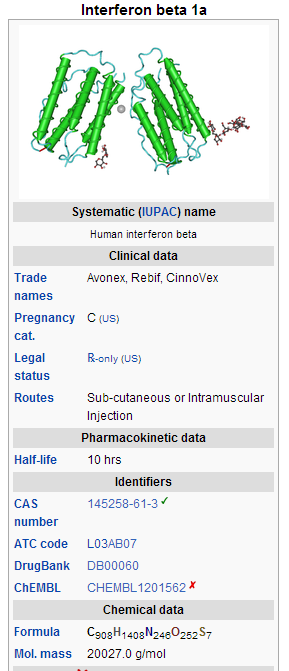
Mechanism of Action
The mechanism of action by which AVONEX exerts its effects in patients with multiple sclerosis is unknown.
Structure
AVONEX is a 166 amino acid glycoprotein with a molecular weight of approximately 22,500 daltons. It is produced by recombinant DNA technology using genetically engineered Chinese Hamster Ovary cells into which the human interferon beta gene has been introduced. The amino acid sequence of AVONEX is identical to that of natural human interferon beta.
Pharmacodynamics
Interferons (IFNs) are a family of naturally occurring proteins, produced by eukaryotic cells in response to viral infection and other biologic agents. Three major types of interferons have been defined: type I (IFN-alpha, beta, epsilon, kappa and omega), type II (IFN gamma) and type III (IFN-lambda). Interferon-beta is a member of the type I subset of interferons. The type I interferons have considerably overlapping but also distinct biologic activities. The bioactivities of all IFNs, including IFN-beta, are induced via their binding to specific receptors on the membranes of human cells. Differences in the bioactivites induced by the three major subtypes of IFNs likely reflect differences in the signal transduction pathways induced by signaling through their cognate receptors.
Interferon beta exerts its biological effects by binding to specific receptors on the surface of human cells. This binding initiates a complex cascade of intracellular events that leads to the expression of numerous interferon-induced gene products and markers. These include 2', 5'-oligoadenylate synthetase, β2-microglobulin, and neopterin. These products have been measured in the serum and cellular fractions of blood collected from patients treated with AVONEX.
Clinical studies conducted in multiple sclerosis patients showed that interleukin 10 (IL-10) levels in cerebrospinal fluid were increased in patients treated with AVONEX compared to placebo. Serum IL-10 levels maximally were increased by 48 hours after intramuscular injection of AVONEX and remained elevated for 1 week. However, no relationship has been established between absolute levels of IL-10 and clinical outcome in multiple sclerosis.
Pharmacokinetics
Pharmacokinetics of AVONEX in multiple sclerosis patients have not been evaluated. The pharmacokinetic and pharmacodynamic profiles of AVONEX in healthy subjects following doses of 30 micrograms through 75 micrograms have been investigated. Serum levels of AVONEX as measured by antiviral activity are slightly above detectable limits following a 30 microgram intramuscular dose, and increase with higher doses.
After an intramuscular dose, serum levels of AVONEX typically peak between 3 and 15 hours and then decline at a rate consistent with a 10 hour elimination half-life. Serum levels of AVONEX may be sustained after intramuscular administration due to prolonged absorption from the intramuscular site. Systemic exposure, as determined by AUC and Cmax values, is greater following intramuscular than subcutaneous (SC) administration.
Subcutaneous administration of AVONEX should not be substituted for intramuscular administration. Subcutaneous and intramuscular administration have been observed to have non-equivalent pharmacokinetic and pharmacodynamic parameters following administration to healthy volunteers.
Biological response markers (e.g., neopterin and β2-microglobulin) are induced by AVONEX following parenteral doses of 15 micrograms through 75 micrograms in healthy subjects and treated patients. Biological response marker levels increase within 12 hours of dosing and remain elevated for at least 4 days. Peak biological response marker levels are typically observed 48 hours after dosing. The relationship of serum AVONEX levels or levels of these induced biological response markers to the mechanisms by which AVONEX exerts its effects in multiple sclerosis is unknown.
Nonclinical Toxicology
Carcinogenesis, Mutagenesis, and Impairment of Fertility
Carcinogenesis: The carcinogenic potential of AVONEX has not been tested in animals.
Mutagenesis: Interferon beta was not mutagenic when tested in an in vitro bacterial reverse mutation (Ames) test or in an in vitro cytogenetic assay in human lymphocytes.
Impairment of Fertility: In monkeys administered interferon beta by subcutaneous injection (8 to 15 doses of 1.25 mcg/kg or 50 mcg/kg) over the course of one menstrual cycle, menstrual irregularities, anovulation, and decreased serum progesterone levels were observed at the higher dose. These effects were reversible after discontinuation of drug. The no-effect dose (1.25 mcg/kg) is approximately 2 times the recommended weekly dose in humans (30 mcg) on a mg/m2 basis.
Clinical Studies
The clinical effects of AVONEX in patients with relapsing forms of multiple sclerosis (MS) were studied in two randomized, multicenter, double-blind, placebo-controlled studies in patients with MS (Studies 1 and 2). Safety and efficacy of treatment with AVONEX beyond 3 years is not known.
In Study 1, 301 patients received either 30 micrograms of AVONEX (n=158) or placebo (n=143) by intramuscular injection once weekly. Patients received injections for up to 2 years, and continued to be followed until study completion. Two hundred eighty-two patients completed 1 year on study, and 172 patients completed 2 years on study. There were 144 patients treated with AVONEX for more than 1 year, 115 patients for more than 18 months and 82 patients for 2 years.
All patients had a definite diagnosis of multiple sclerosis of at least 1 year duration and had at least 2 exacerbations in the 3 years prior to study entry (or 1 per year if the duration of disease was less than 3 years). At entry, study participants were without exacerbation during the prior 2 months and had Kurtzke Expanded Disability Status Scale (EDSS3) scores ranging from 1.0 to 3.5. The EDSS is a scale that quantifies disability in patients with MS and ranges from 0 (normal neurologic exam) to 10 (death due to MS). Patients with chronic progressive multiple sclerosis were excluded from this study.
Disability
The primary outcome assessment was time to progression in disability, measured as an increase in the EDSS score of at least 1 point that was sustained for at least 6 months. An increase in EDSS score reflects accumulation of disability. This endpoint was used to help distinguish permanent increase in disability from a transient increase due to an exacerbation.
As shown in Figure 1, the time to onset of sustained progression in disability was significantly longer in AVONEX-treated patients than in placebo-treated patients in Study 1 (p = 0.02). The percentage of patients progressing by the end of 2 years was 35% for placebo-treated patients and 22% for AVONEX-treated patients. This represents a 37% relative reduction in the risk of accumulating disability in the AVONEX-treated group compared to the placebo-treated group.

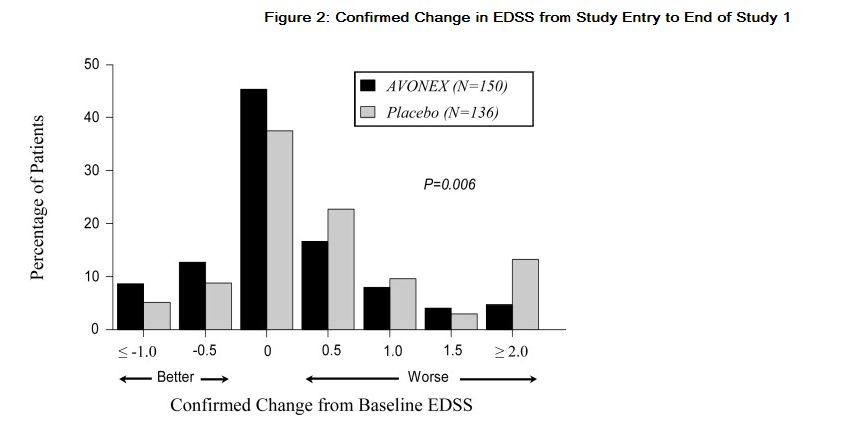
Exacerbations
The rate and frequency of MS exacerbations were secondary outcomes. For all patients included in the study, irrespective of time on study, the annual exacerbation rate was 0.67 per year in the AVONEX-treated group and 0.82 per year in the placebo-treated group (p = 0.04). AVONEX treatment significantly decreased the frequency of exacerbations in the subset of patients who were enrolled in the study for at least 2 years (87 placebo-treated patients and 85 AVONEX-treated patients; p = 0.03; see Table 3).
MRI Results
Gadolinium (Gd)-enhanced and T2-weighted magnetic resonance imaging (MRI) scans of the brain were obtained in most patients at baseline and at the end of 1 and 2 years of treatment.
Secondary outcomes included Gd-enhanced lesion number and volume, and T2-weighted lesion volume. Gd-enhancing lesions seen on brain MRI scans represent areas of breakdown of the blood brain barrier thought to be secondary to inflammation. AVONEX-treated patients demonstrated significantly lower Gd-enhanced lesion number after 1 and 2 years of treatment than placebo-treated patients (p ≤ 0.05; see Table 3). The volume of Gd-enhanced lesions showed similar treatment effects in the AVONEX and placebo groups (p ≤ 0.03). Percentage change in T2-weighted lesion volume from study entry to Year 1 was significantly lower in AVONEX-treated than placebo-treated patients (p = 0.02). A significant difference in T2-weighted lesion volume change was not seen between study entry and Year 2 in the AVONEX and placebo groups.
The exact relationship between MRI findings and the clinical status of MS patients is unknown. The prognostic significance of MRI findings in these studies has not been evaluated.
Summary of Effects of Clinical and MRI Endpoints in Study 1
A summary of the effects of AVONEX on the clinical and MRI endpoints of this study is presented in Table 3.
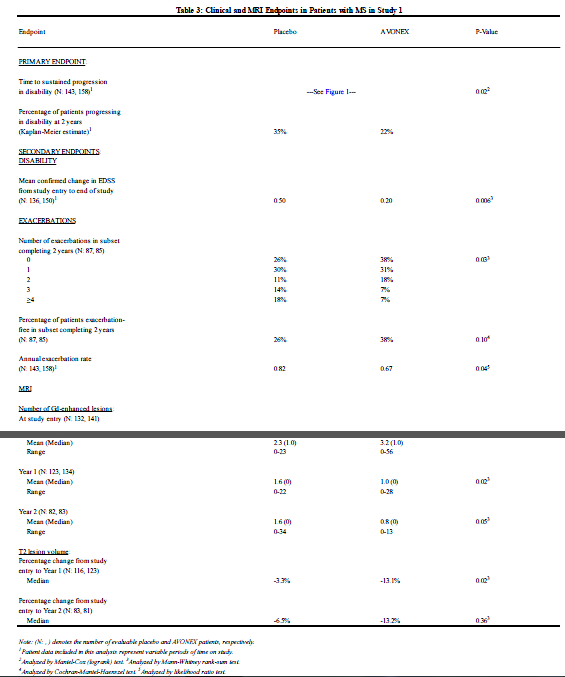
In Study 2, 383 patients who had recently experienced an isolated demyelinating event involving the optic nerve, spinal cord, or brainstem/cerebellum, and who had lesions typical of multiple sclerosis on brain MRI, received either 30 micrograms of AVONEX (n = 193) or placebo (n = 190) by intramuscular injection once weekly. Patients were enrolled into the study over a two-year period and followed for up to three years or until they developed a second clinical exacerbation in an anatomically distinct region of the central nervous system.
Exacerbations
In Study 2, the primary outcome measure was time to development of a second exacerbation in an anatomically distinct region of the central nervous system. Time to development of a second exacerbation was significantly delayed in AVONEX-treated compared to placebo-treated patients (p = 0.002). The Kaplan-Meier estimates of the percentage of patients developing an exacerbation within 24 months were 39% in the placebo group and 21% in the AVONEX group (see Figure 3). The relative rate of developing a second exacerbation in the AVONEX group was 0.56 of the rate in the placebo group (95% confidence interval 0.38 to 0.81).
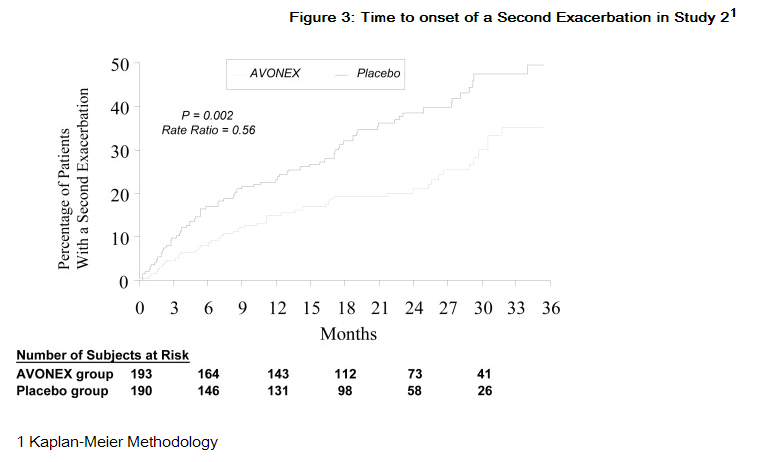
MRI Findings
Secondary outcomes were brain MRI measures, including the cumulative increase in the number of new or enlarging T2 lesions, T2 lesion volume at baseline compared to results at 18 months, and the number of Gd-enhancing lesions at 6 months. See Table 4 for the MRI results.
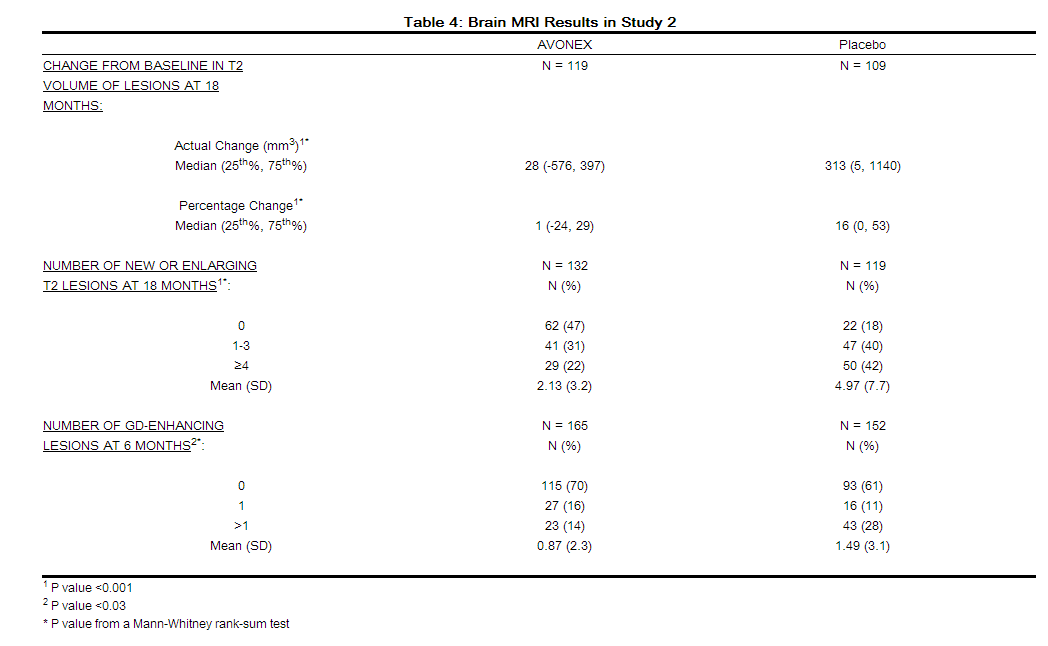
How Supplied
AVONEX Lyophilized Powder Vial
A vial of AVONEX is supplied as a lyophilized powder in a single-use vial containing 33 micrograms (6.6 million international units) of interferon beta-1a; 16.5 mg Albumin (Human), USP; 6.4 mg Sodium Chloride, USP; 6.3 mg Dibasic Sodium Phosphate, USP; and 1.3 mg Monobasic Sodium Phosphate, USP, and is preservative-free. Diluent is supplied in a single-use vial (Sterile Water for Injection, USP).
AVONEX lyophilized vials are available in the following package configuration (NDC 59627-001-03): A package containing four Administration Dose Packs (each containing one vial of AVONEX, one 10 mL diluent vial, two alcohol wipes, one gauze pad, one 3 mL syringe, one MICRO PIN®* vial access pin, one 23 gauge, 1¼ inch needle, and one adhesive bandage).
AVONEX Single-Use Prefilled Syringe
A prefilled syringe of AVONEX is supplied as a sterile liquid albumin-free formulation containing 30 micrograms of interferon beta-1a, 0.79 mg Sodium Acetate Trihydrate, USP; 0.25 mg Glacial Acetic Acid, USP; 15.8 mg Arginine Hydrochloride, USP; and 0.025 mg Polysorbate 20 in Water for Injection, USP. Each prefilled glass syringe contains 0.5 mL for Intramuscular injection.
AVONEX prefilled syringes are available in the following package configuration (NDC 59627-002-05): A package containing four Administration Dose Packs (each containing one single-use syringe of AVONEX and one 23 gauge, 1¼ inch needle), and a recloseable accessory pouch containing 4 alcohol wipes, 4 gauze pads, and 4 adhesive bandages.
AVONEX PEN Single-Use Prefilled Autoinjector
AVONEX PEN is supplied as a sterile liquid albumin-free formulation containing 30 micrograms of interferon beta-1a, 0.79 mg Sodium Acetate Trihydrate, USP; 0.25 mg Glacial Acetic Acid, USP; 15.8 mg Arginine Hydrochloride, USP; and 0.025 mg Polysorbate 20 in Water for Injection, USP. Each single-use prefilled autoinjector contains 0.5 mL for intramuscular injection.
AVONEX PEN single-use prefilled autoinjectors are available in the following package configuration (NDC 59627-003-04): A package containing four AVONEX PEN Administration Dose Packs (each containing one AVONEX PEN autoinjector, one 25 gauge, 5/8 inch needle and an AVONEX PEN cover), and a recloseable accessory pouch containing 4 alcohol wipes, 4 gauze pads, and 4 adhesive bandages.
Storage
AVONEX Lyophilized Powder Vial
Vials of AVONEX should be stored in a 2°C to 8°C (36°F to 46°F) refrigerator. Should refrigeration be unavailable, vials of AVONEX can be stored at 25°C (77°F) for a period of up to 30 days. DO NOT EXPOSE TO HIGH TEMPERATURES. DO NOT FREEZE. Protect from light. Do not use beyond the expiration date stamped on the vial. Following reconstitution, it is recommended the product be used as soon as possible within 6 hours stored at 2°C to 8°C (36°F to 46°F). DO NOT FREEZE RECONSTITUTED AVONEX.
AVONEX Single-Use Prefilled Syringe
AVONEX in prefilled syringes should be stored in a 2°C to 8°C (36°F to 46°F) refrigerator. Once removed from the refrigerator, AVONEX in a prefilled syringe should be allowed to warm to room temperature (about 30 minutes). Do not use external heat sources such as hot water to warm AVONEX in a prefilled syringe. Should refrigeration be unavailable, AVONEX in a prefilled syringe can be stored at ≤ 25°C (77°F) for a period up to 7 days. Once the product is removed from the refrigerator, it must not be stored above 25°C (77°F). If the product has been exposed to conditions other than those recommended, DISCARD THE PRODUCT and DO NOT USE. DO NOT EXPOSE TO HIGH TEMPERATURES. DO NOT FREEZE. Protect from light. Do not use beyond the expiration date stamped on the syringe.
AVONEX PEN Single-Use Prefilled Autoinjector
AVONEX PEN should be stored in a 2°C to 8°C (36°F to 46°F) refrigerator. Once removed from the refrigerator, AVONEX PEN should be allowed to warm to room temperature (about 30 minutes). Do not use external heat sources such as hot water to warm AVONEX. Should refrigeration be unavailable, AVONEX PEN can be stored at ≤ 25°C (77°F) for a period up to 7 days. Once the product is removed from the refrigerator, it must not be stored above 25°C (77°F). If the product has been exposed to conditions other than those recommended,
DISCARD THE PRODUCT and DO NOT USE. DO NOT EXPOSE TO HIGH TEMPERATURES. DO NOT FREEZE. Protect from light. Do not use beyond the expiration date stamped on the prefilled autoinjector.
Images
Drug Images
{{#ask: Page Name::Interferon beta-1a |?Pill Name |?Drug Name |?Pill Ingred |?Pill Imprint |?Pill Dosage |?Pill Color |?Pill Shape |?Pill Size (mm) |?Pill Scoring |?NDC |?Drug Author |format=template |template=DrugPageImages |mainlabel=- |sort=Pill Name }}
Package and Label Display Panel
PACKAGE LABEL – PRINCIPAL DISPLAY PANEL – Single-Use Prefilled Autoinjector 4 Pack Carton
NDC 59627-003-04
AVONEX®
(interferon beta-1a)
Rx only
Package contains: 4 Administration Dose Packs and a recloseable accessory pouch containing 4 alcohol wipes, 4 gauze pads, and 4 adhesive bandages.
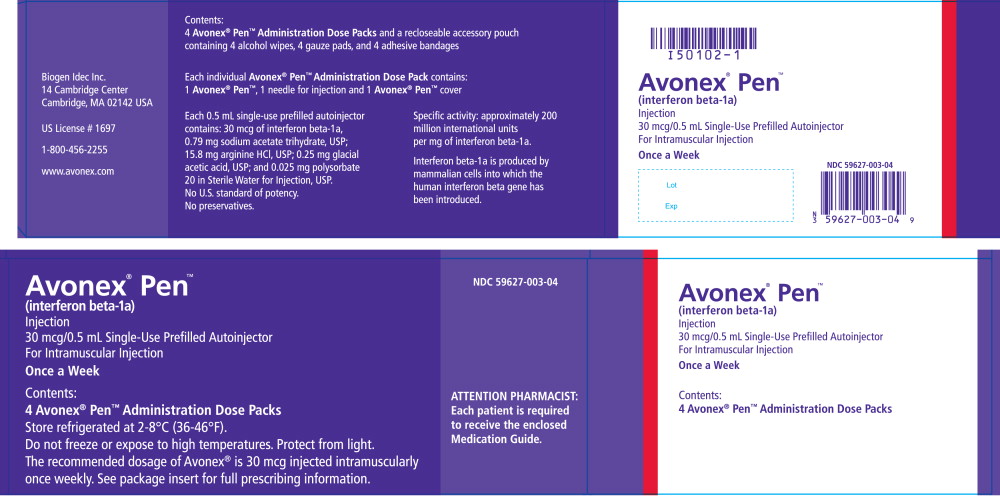
PACKAGE LABEL – PRINCIPAL DISPLAY PANEL – Single-Use Prefilled Autoinjector Pen 1 Pack Carton
NDC 59627-003-01
AVONEX®
(interferon beta-1a)
Rx only
Single-Use Prefilled Autoinjector Pen
Package contains: 1 Single-Use Prefilled Autoinjector Pen containing 30 mcg interferon beta-1a
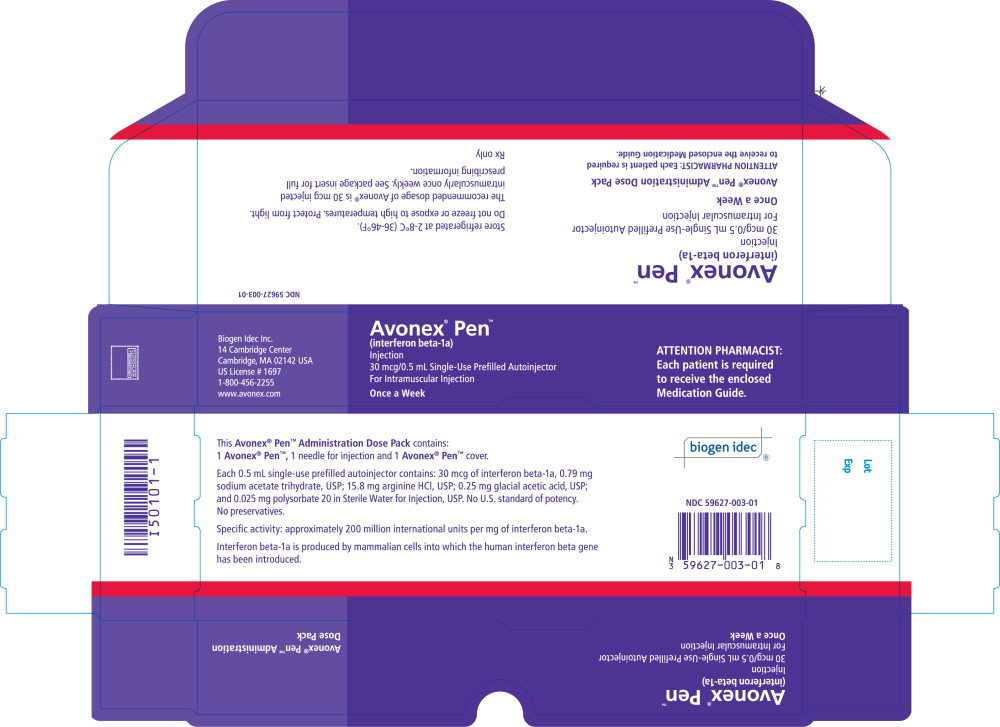
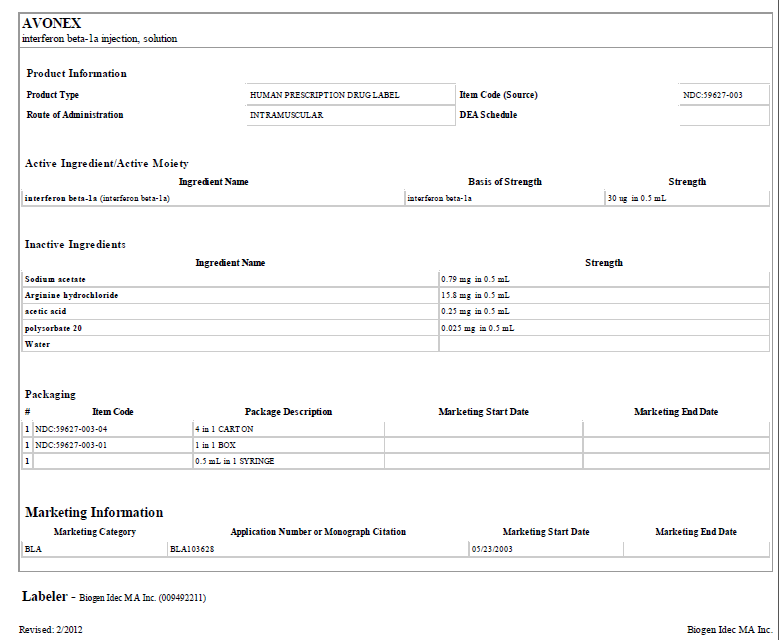
{{#ask: Label Page::Interferon beta-1a |?Label Name |format=template |template=DrugLabelImages |mainlabel=- |sort=Label Page }}
Patient Counseling Information
See FDA-approved patient labeling (Medication Guide and Patient's Instructions for Use).
Instruct patients to carefully read the supplied AVONEX Medication Guide and caution patients not to change the AVONEX dose or schedule of administration without medical consultation.
Instruction on Self-injection Technique and Procedures
Provide appropriate instruction for reconstitution of AVONEX and methods of self-injection, including careful review of the AVONEX Medication Guide. Instruct patients in the use of aseptic technique when administering AVONEX.
Inform patients that their healthcare provider should show them or their caregiver how to prepare and inject AVONEX before administering the first dose. Their healthcare provider should watch the first AVONEX injection given. Tell patients not to re-use needles or syringes and instruct patients on safe disposal procedures. Inform patients to dispose of used needles and syringes in a puncture-resistant container and instruct the patient regarding safe disposal of full containers.
Advise patients:
- of the importance of rotating areas of injection with each dose to minimize the likelihood of injection site reactions. [see Choose an Injection Site section of the Medication Guide].
- NOT to inject area of the body where the skin is irritated, reddened, bruised, infected or scarred in any way
- to check the injection site after 2 hours for redness, swelling, or tenderness
contact their doctor or nurse if they have a skin reaction and it does not clear up in a few days
Pregnancy
Advise patients that AVONEX should not be used during pregnancy unless the potential benefit justifies the potential risk to the fetus.
Depression
Advise patients of the symptoms of depression, suicidal ideation, or psychotic disorders as they have been reported with the use of AVONEX and instruct patients to report them immediately to their physician.
Liver Disease
Advise patients that severe hepatic injury, including hepatic failure, has been reported during the use of AVONEX. Advise patients of symptoms of hepatic dysfunction, and instruct patients to report them immediately to their physician.
Allergic Reactions and Anaphylaxis
Advise patients of the symptoms of allergic reactions and anaphylaxis, and instruct patients to seek immediate medical attention if these symptoms occur.
Congestive Heart Failure
Advise patients that worsening of pre-existing congestive heart failure has been reported in patients using AVONEX. Advise patients of symptoms of worsening cardiac condition, and instruct patients to report them immediately to their physician.
Seizures
Advise patients that seizures have been reported in patients using AVONEX. Instruct patients to report seizures immediately to their physician.
Flu-like Symptoms
Inform patients that flu-like symptoms are common following initiation of therapy with AVONEX. Advise patients that starting with a lower dose than 30 micrograms and increasing the dose over 3 weeks reduces the incidence and severity of flu-like symptoms.
Manufactured by:
BIOGEN IDEC INC.
14 Cambridge Center
Cambridge, MA 02142 USA
©1996-2012 Biogen Idec Inc. All rights reserved.
1-800-456-2255
- Micro Pin® is the trademark of B. Braun Medical Inc.
AVONEX® (a-vuh-necks)
(interferon beta-1a)
Injection for intramuscular use
Read this Medication Guide before you start using AVONEX, and each time you get a refill. There may be new information. This information does not take the place of talking with your healthcare provider about your medical condition or your treatment.
What is the most important information I should know about AVONEX?
AVONEX can cause serious side effects. Tell your healthcare provider right away if you have any of the symptoms listed below while taking AVONEX.
Behavioral health problems including depression, suicidal thoughts or hallucinations. Some people taking AVONEX may develop mood or behavior problems including:
- irritability (getting upset easily)
- depression (feeling hopeless or feeling bad about yourself)
- nervousness
- anxiety
- aggressive behavior
- thoughts of hurting yourself or suicide
- hearing or seeing things that others do not hear or see (hallucinations)
Liver problems, or worsening of liver problems including liver failure and death. Symptoms may include:
- nausea
- loss of appetite
- tiredness
- dark colored urine and pale stools
- yellowing of your skin or the white part of your eye
- bleeding more easily than normal
- confusion
- sleepiness
During your treatment with AVONEX you will need to see your healthcare provider regularly and have regular blood tests to check for side effects.
Serious allergic reactions and skin reactions. Symptoms may include:
- itching
- swelling of the face, eyes, lips, tongue or throat
- trouble breathing
- anxiousness
- feeling faint
- skin rash, hives, sores in your mouth, or your skin blisters and peels
What is AVONEX?
AVONEX is a form of a protein called beta interferon that occurs naturally in the body.
AVONEX is a prescription medicine used to treat adults with relapsing forms of multiple sclerosis (MS). This includes people who have had their first symptoms of multiple sclerosis and have an MRI consistent with multiple sclerosis.
AVONEX will not cure your MS but may decrease the number of flare-ups of the disease and slow the occurrence of some of the physical disability that is common in people with MS. MS is a life-long disease that affects your nervous system by destroying the protective covering (myelin) that surrounds your nerve fibers.
The way AVONEX works in MS is not known.
It is not known if AVONEX is safe and effective in children.
Who should not use AVONEX?
Do not take AVONEX if you:
- are allergic to interferon beta, albumin (human), or any of the ingredients in AVONEX. See the end of this Medication Guide for a complete list of ingredients in AVONEX.
What should I tell my healthcare provider before using AVONEX?
Before taking AVONEX, tell your healthcare provider if you:
- are being treated for a mental illness or had treatment in the past for any mental illness, including depression and suicidal behavior
- have or had bleeding problems or blood clots
- have or had low blood cell counts
- have or had liver problems
- have or had seizures (epilepsy)
- have or had heart problems
- have or had thyroid problems
- have or had any kind of autoimmune disease (where the body's immune system attacks the body's own cells), such as psoriasis, systemic lupus erythematosus, or rheumatoid arthritis
- drink alcohol
- are pregnant or plan to become pregnant. It is not known if AVONEX will harm your unborn baby. Tell your healthcare provider if you become pregnant during your treatment with AVONEX.
- are breastfeeding or plan to breastfeed. It is not known if AVONEX passes into your breast milk. You and your healthcare provider should decide if you will use AVONEX or breastfeed. You should not do both.
Tell your healthcare provider about all the medicines you take, including prescription and non-prescription medicines, vitamins, and herbal supplements.
How should I use AVONEX?
- Your healthcare provider should show you how to prepare and measure your dose of AVONEX and how to inject your AVONEX before you use AVONEX for the first time.
- Your healthcare provider or nurse should watch the first AVONEX injection you give yourself.
AVONEX is given once a week by injection into the muscle (intramuscular injection).
- Inject AVONEX exactly as your healthcare provider tells you.
- Your healthcare provider will tell you how much AVONEX to inject and how often to inject AVONEX. Do not inject more than your healthcare provider tells you to.
- Do not change your dose unless your healthcare provider tells you to.
- Change (rotate) your injection site you choose with each injection. This will help decrease the chance that you will have an injection site reaction.
- Do not inject into an area of the body where the skin is irritated, reddened, bruised, infected or scarred in any way.
- AVONEX comes as a:
- Vial with freeze-dried (lyophilized) powder
- Prefilled syringe (can be used with the AVOSTARTGRIP™ titration kit)
- Single-Use Prefilled Autoinjector Pen (AVONEX® PEN™)
Your healthcare provider will decide which one is best for you. See the Instructions for Use at the end of this Medication Guide for detailed instructions for preparing and injecting your dose of AVONEX.
- Always use a new, unopened AVONEX vial, prefilled syringe, or single-use prefilled autoinjector pen for each intramuscular injection.
What are the possible side effects of AVONEX?
AVONEX can cause serious side effects including:
See “What is the most important information I should know about AVONEX?”
Heart problems, including heart failure. While AVONEX is not known to have any direct effects on the heart, a few patients who did not have a history of heart problems developed heart muscle problems or congestive heart failure after taking AVONEX. If you already have heart failure, AVONEX may cause your heart failure to get worse. Call your healthcare provider right away if you have worsening symptoms of heart failure such as shortness of breath or swelling of your lower legs or feet while using AVONEX. Some people using AVONEX may have other heart problems including:
- low blood pressure
- fast or abnormal heart beat
- chest pain
- heart attack or a heart muscle problem (cardiomyopathy)
Blood problems. AVONEX can affect your bone marrow and cause low red and white blood cell, and platelet counts. In some people, these blood cell counts may fall to dangerously low levels. If your blood cell counts become very low, you can get infections and problems with bleeding and bruising.
Seizures. Some patients have had seizures while taking AVONEX, including patients who have never had seizures before. Infections. Some people who take AVONEX may get an infection. Symptoms of an infection may include:
- fever
- chills
- pain or burning with urination
- urinating often
- bloody diarrhea
- coughing up mucus
Thyroid problems. Some people taking AVONEX develop changes in their thyroid function.
Symptoms of thyroid changes include:
- problems concentrating
- feeling cold or hot all the time
- weight changes (gain or loss)
- skin changes
Tell your healthcare provider right away if you have any of the symptoms listed above.
The most common side effects of AVONEX include:
Flu-like symptoms. Most people who take AVONEX have flu-like symptoms early during the course of therapy. Usually, these symptoms last for a day after the injection. You may be able to manage these flu-like symptoms by taking over-the-counter pain and fever reducers.
For many people, these symptoms lessen or go away over time. Symptoms may include:
- muscle aches
- fever
- tiredness
- chills
Call your doctor for medical advice about side effects. You may report side effects to FDA at 1-800-FDA-1088.
How should I store AVONEX?
- Store AVONEX in the refrigerator at 36°F to 46°F (2°C to 8°C).
- Do not freeze AVONEX. Do not use AVONEX that has been frozen.
- Do not store AVONEX above 77°F (25°C).
- Keep AVONEX away from light.
- Do not use AVONEX past the expiration date.
- If you cannot refrigerate your AVONEX vials, you can store your AVONEX vials at 77°F (25°C) for up to 30 days. After mixing, the AVONEX solution should be used immediately, within 6 hours when stored refrigerated at 36°F to 46°F (2°C to 8°C).
- If you cannot refrigerate your AVONEX PEN and AVONEX prefilled syringes, you can store your AVONEX PEN and AVONEX prefilled syringes up to 77°F (25°C) for up to 7 days.
Keep AVONEX vials, prefilled syringes, pens and all other medicines out of the reach of children.
General advice about the safe and effective use of AVONEX
Medicines are sometimes prescribed for purposes other than those listed in a Medication Guide. Do not use AVONEX for a condition for which it was not prescribed. Do not give AVONEX to other people, even if they have the same symptoms that you have, it may harm them.
This Medication Guide summarizes the most important information about AVONEX. If you would like more information, talk with your healthcare provider. You may ask your healthcare provider or pharmacist for information about AVONEX that is written for healthcare professionals.
What are the ingredients in AVONEX?
Active ingredient: interferon beta-1a
Inactive ingredients:
Vial with freeze-dried (lyophilized) powder: albumin (human), sodium chloride, dibasic sodium phosphate, and monobasic sodium phosphate.
Single-Use Prefilled Syringe: sodium acetate trihydrate, glacial acetic acid, arginine hydrochloride, polysorbate 20 in water for injection.
Single-Use Prefilled Autoinjector Pen: sodium acetate trihydrate, glacial acetic acid, arginine hydrochloride, polysorbate 20 in water for injection.
This Medication Guide has been approved by the U.S. Food and Drug Administration.
Manufactured by:
BIOGEN IDEC INC.
14 Cambridge Center
Cambridge, MA 02142 USA
©1996-2012 Biogen Idec Inc. All rights reserved.
1-800-456-2255
Revised 02/2012
Instructions for Use
AVONEX® PEN™ (a-vuh-necks) (pen)
(interferon beta-1a) injection for intramuscular use
single-use prefilled autoinjector pen
Read the Instructions for Use before you start using AVONEX and each time you get a refill. There may be new information. This information does not take the place of talking to your healthcare provider about your medical condition or your treatment.
Your healthcare provider should show you or your caregiver how to prepare the dose of AVONEX and how to inject your AVONEX PEN the right way before AVONEX PEN is used for the first time. Your healthcare provider or nurse should watch you inject the dose of AVONEX the first time AVONEX PEN is used.
Preparing the AVONEX PEN:
Find a well lit, clean, flat work surface like a table and collect all the supplies you will need to give yourself or receive an injection.
Take 1 AVONEX PEN Administration Dose Pack out of the refrigerator about 30 minutes before you plan on injecting the AVONEX dose to allow it to reach room temperature. Do not use external heat sources such as hot water to warm the AVONEX PEN.
Check the expiration date printed on the AVONEX PEN, AVONEX PEN Administration Dose Package carton, and the outer carton. Do not use the AVONEX PEN past the expiration date.
Wash your hands with soap and water.
Supplies you will need to give the AVONEX PEN injection:
- 1 AVONEX Administration Dose Pack that contains:
- 1 AVONEX PEN
- a 25 gauge, 5/8 inch long sterile needle
- 1 AVONEX PEN cover
- 1 alcohol wipe
- 1 gauze pad
- 1 adhesive bandage
- a puncture resistant container for disposal of used AVONEX PEN and needle
Identifying parts of the AVONEX PEN (See Figure A).
Single-Use Administration Dose Pack Contents - AVONEX PEN, Supplied Needle and AVONEX PEN Cover
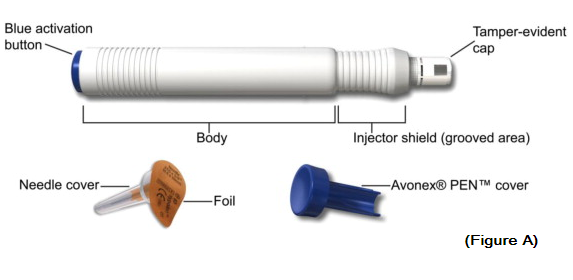

Precautions with Alcohol
The potential risk of AVONEX used with alcohol should be considered prior to starting AVONEX.
Brand Names
AVONEX®
Look-Alike Drug Names
There is limited information regarding Interferon beta-1a Look-Alike Drug Names in the drug label.
Drug Shortage Status
Price
References
The contents of this FDA label are provided by the National Library of Medicine.